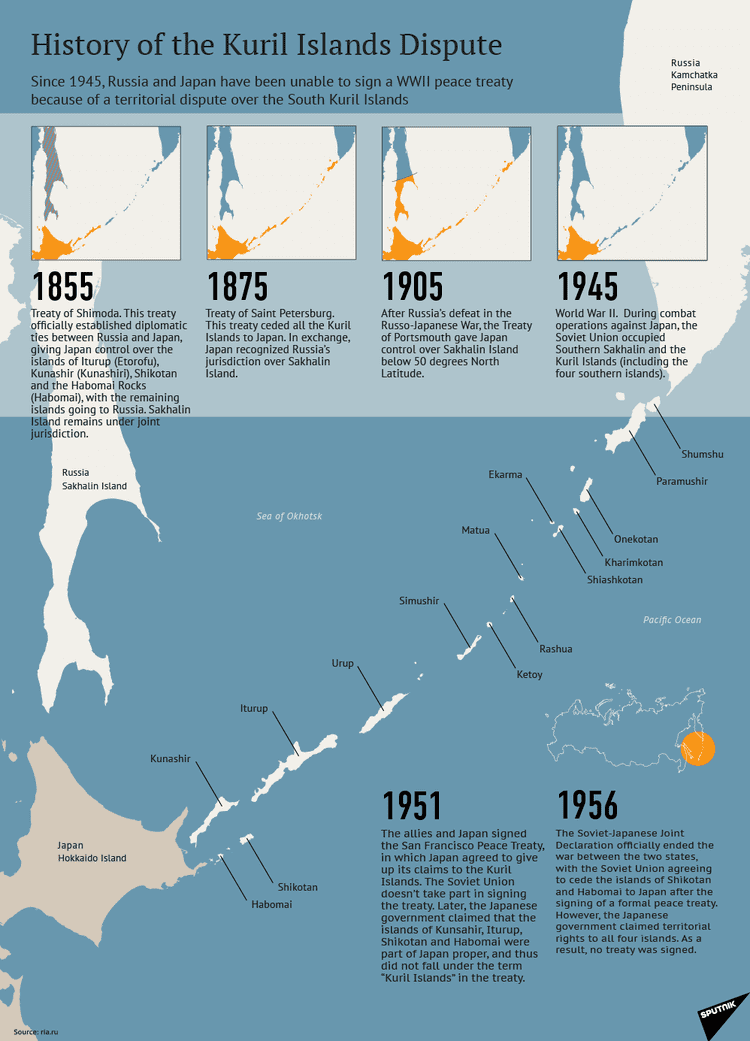 | ||
The Kuril Islands dispute (Russian: Спор о принадлежности Курильских островов, Spor o prinadlezhnosti Kuril'skikh ostrovov), also known as the Northern Territories dispute (Japanese: 北方領土問題, Hoppō Ryōdo Mondai), is a dispute between Japan and Russia and also some individuals of the Ainu people over sovereignty of the South Kuril Islands. The disputed islands, like other islands in the Kuril chain that are not in dispute, were annexed by the Soviet Union in aftermath of the Kuril Islands landing operation at the end of World War II. The disputed islands are under Russian administration as the South Kuril District of the Sakhalin Oblast (Сахалинская область, Sakhalinskaya oblast). They are claimed by Japan, which refers to them as its Northern Territories (北方領土, Hoppō Ryōdo) or Southern Chishima (南千島, Minami Chishima), and considers them part of the Nemuro Subprefecture of Hokkaido Prefecture.
Contents
- Background
- World War II agreements
- Yalta Conference
- San Francisco Treaty
- 1956 SovietJapanese Joint Declaration
- Dispute over the composition of the Kuril islands
- 21st century developments
- Visa issues
- Visit by President Medvedev
- Reinforcement of defences
- Russian fighter jets intrusion
- 2013 Abe visit to Moscow
- Japans view
- Public attitudes in Japan
- Russias view
- Public attitudes in Russia
- Ainu view
- Interests of both parties
- Political and strategic issues
- Natural resources
- Emotive issues
- References

The San Francisco Peace Treaty with Japan from 1951 states that Japan must give up all claims to the Kuril Islands, but it also does not recognize the Soviet Union's sovereignty over the Kuril Islands. Furthermore, Japan claims that at least some of the disputed islands are not a part of the Kuril Islands, and thus are not covered by the treaty. Russia maintains that the Soviet Union's sovereignty over the islands was recognized following agreements at the end of the Second World War. However, Japan has disputed this claim. The disputed islands are:
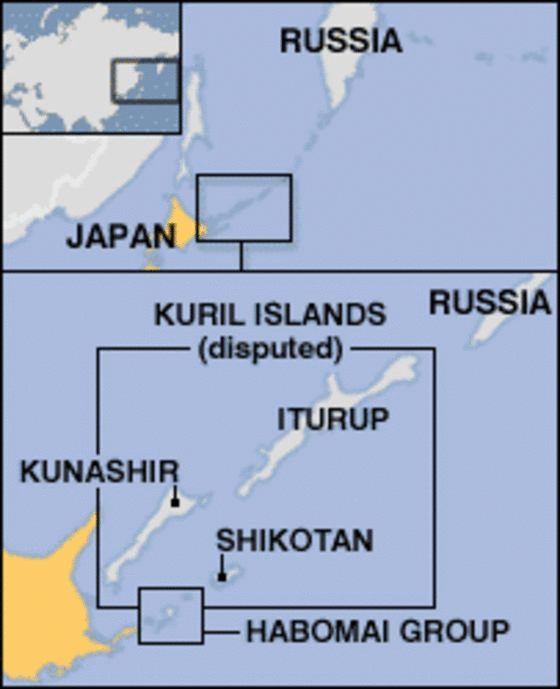

Background
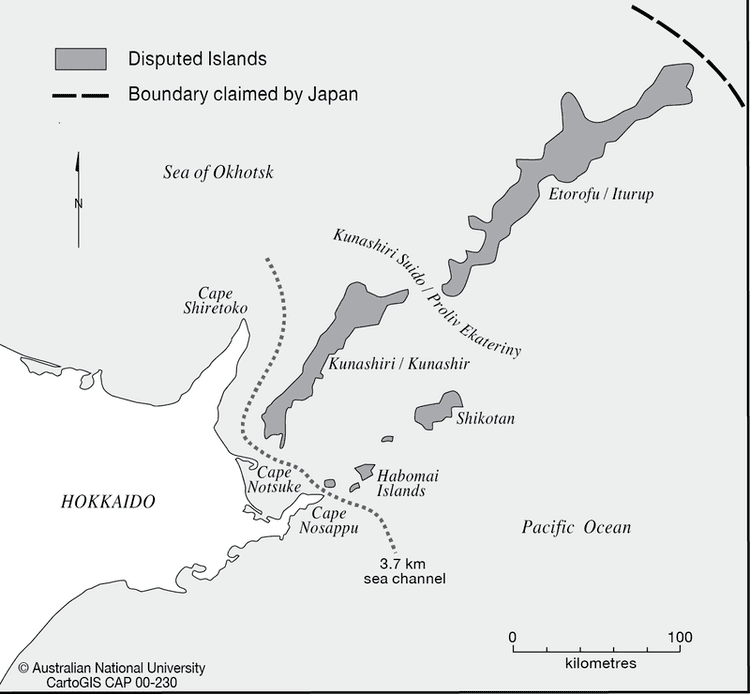
The first Russo-Japanese agreement to deal with the status of Sakhalin and the Kuril Islands was the 1855 Treaty of Shimoda, which first established official relations between Russia and Japan. Article 2 of the Treaty of Shimoda, which provided for an agreement on borders, states "Henceforth the boundary between the two nations shall lie between the islands of Etorofu and Uruppu. The whole of Etorofu shall belong to Japan; and the Kuril Islands, lying to the north of and including Uruppu, shall belong to Russia." The islands of Kunashiri, Shikotan and the Habomai Islands, that all lie to the south of Etorofu, are not explicitly mentioned in the treaty and were understood at the time to be a non-disputed part of Japan. The treaty also specified that the island of Sakhalin/Karafuto was not to be partitioned but was to remain under a joint Russo-Japanese condominium.
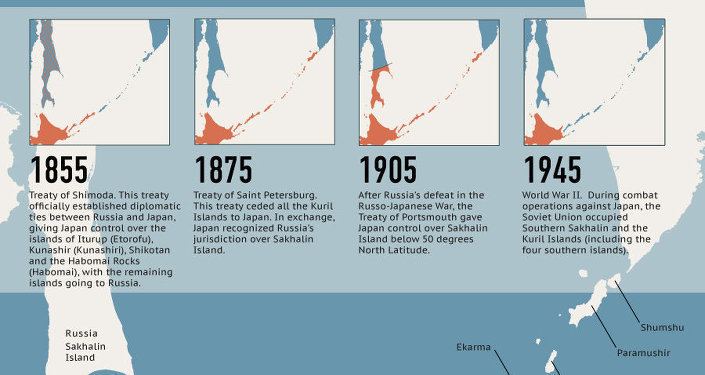
In the 1875 Treaty of Saint Petersburg Russia and Japan agreed that Japan would give up all rights to Sakhalin in exchange for Russia giving up all rights to the Kuril Islands in favor of Japan.
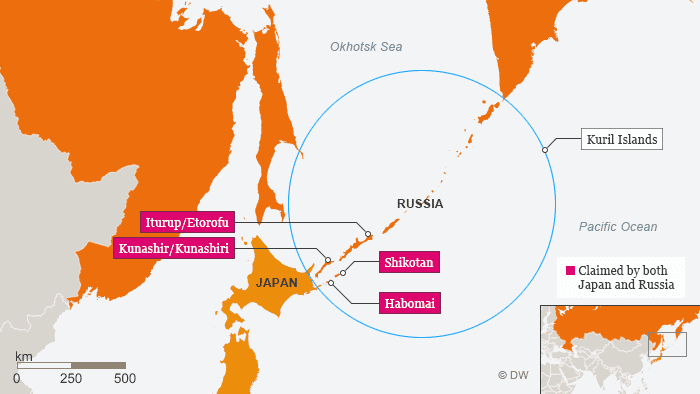
The Russo-Japanese War of 1904–1905 was a military disaster for Russia. The 1905 Treaty of Portsmouth, concluded at the end of this war, gave the southern half of Sakhalin Island to Japan.

Although Japan occupied parts of Russia's Far East during the Russian Civil War following the October Revolution, Japan did not formally annex any of these territories and they were vacated by Japan by the mid-1920s.
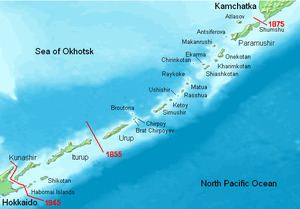
There was practically no hostile activity between the USSR and the Empire of Japan after the Battle of Khalkin Gol ended the Japanese–Soviet Border War in 1939 and before the USSR declared war on Japan (Manchurian Strategic Offensive Operation) on August 8, 1945. The Soviet–Japanese Neutrality Pact was signed in Moscow on April 13, 1941, but was unilaterally renounced by the Soviet Union in 1945. On August 14, 1945, Japan accepted the Potsdam Declaration and on the following day announced unconditional capitulation. The Soviet operation to occupy the Kuril Islands took place between August 18 and September 3. Japanese inhabitants were repatriated two years later.
World War II agreements
The modern Kuril Islands dispute arose in the aftermath of World War II and results from the ambiguities in and disagreements about the meaning of the Yalta agreement (February 1945), the Potsdam Declaration (July 1945) and the Treaty of San Francisco (September 1951). The Yalta Agreement, signed by the US, Great Britain and the Soviet Union, stated:
The leaders of the three great powers – the Soviet Union, the United States of America and Great Britain – have agreed that in two or three months after Germany has surrendered and the war in Europe is terminated, the Soviet Union shall enter into war against Japan on the side of the Allies on condition that: ... 2. The former rights of Russia violated by the treacherous attack of Japan in 1904 shall be restored, viz.: (a) The southern part of Sakhalin as well as the islands adjacent to it shall be returned to the Soviet Union; ... 3. The Kurile Islands shall be handed over to the Soviet Union.
Japan and the US claimed that the Yalta agreement did not apply to the Northern Territories because they were not a part of the Kuril Islands, although US geographers have traditionally listed them as part of the Kuril chain. In a 1998 article in the journal Pacific Affairs, Bruce Elleman, Michael Nichols and Matthew Ouimet argue that the US never accepted the cession of all the Kuril Islands to the Soviet Union and has maintained from Yalta onwards that it simply agreed at Yalta that Moscow could negotiate directly with Tokyo to come to a mutually acceptable solution, and that the US would support in such a peace agreement the Soviet acquisition of the Kurils. As a key piece of evidence, the same article (page 494 of) quotes an August 27, 1945 letter from U.S President Harry Truman to Soviet Premier Joseph Stalin: "You evidently misunderstood my message [about the Kuril Islands] ... I was not speaking of any territory of the Soviet Republic. I was speaking of the Kurile Islands, Japanese territory, disposition of which must be made at a peace settlement. I was advised that my predecessor agreed to support in the peace settlement the Soviet acquisition of those islands." The Soviet Union—and subsequently, Russia—rejected this position.
The Potsdam Declaration states the following regarding the Japanese territories: "8. The terms of the Cairo Declaration shall be carried out and Japanese sovereignty shall be limited to the islands of Honshū, Hokkaido, Kyushu, Shikoku and such minor islands as we determine". The islands comprising the Northern Territories are not explicitly included in this list, but the US subsequently maintained, particularly during the preparation of the Treaty of San Francisco, that the phrase "and such minor islands as we determine" could be used to justify transferring the Northern Territories to Japan.
The Cairo Declaration of 1943 did not explicitly mention the Kuril Islands but stated: "Japan will also be expelled from all other territories which she has taken by violence and greed".
Japan later claimed that the Cairo Declaration and the Potsdam Declaration did not apply to the islands on the grounds that they had never belonged to Russia or been claimed by it since the establishment of diplomatic relations between the two countries in 1855, and thus they were not among the territories acquired by Japan "by violence and greed".
Yalta Conference
English version of Yalta Conference documents about Kuril Islands: Page 1 Page 2
A separate document at the Yalta Conference decided the fate of the Far East. In exchange for entry into the war against Japan in two-to-three months after the end of war in Europe, the Soviet Union received the Kuril Islands and southern Sakhalin, more than it lost in the Russian-Japanese war, and Mongolia was recognized as an independent state. The Soviet side also promised to rent Port Arthur and the Chinese Eastern Railway (CER).
US President Franklin D. Roosevelt wanted the Soviet Union to enter the Pacific War with the Allies. One Soviet precondition for a declaration of war against Japan was an American official recognition of Mongolian independence from China (the Mongolian People's Republic had already been the Soviet satellite state in World War I and World War II), and a recognition of Soviet interests in the Manchurian railways and Port Arthur (but not asking the Chinese to lease), and the return of Sakhalin and Kuril Islands to Russian custody; these were agreed without Chinese representation, consultation or consent, with the American desire to end war early by reducing American casualties. Stalin agreed that the Soviet Union would enter the Pacific War three months after the defeat of Germany. Stalin pledged to Roosevelt to keep the nationality of the Korean Peninsula intact as the Soviet Union entered the war against Japan.
San Francisco Treaty
A substantial dispute regarding the status of the Kuril Islands arose between the U.S. and the Soviet Union during the preparation of the Treaty of San Francisco in 1951. The Treaty was supposed to be a permanent peace treaty between Japan and the Allied Powers of World War II. By that time, the Cold War had already taken hold, and the position of the U.S. in relation to the Yalta and Potsdam agreements had changed considerably. The U.S. had come to maintain that the Potsdam Declaration should take precedence and that strict adherence to the Yalta agreement was not necessary since, in the view of the U.S., the Soviet Union itself violated several provisions of the Yalta agreement in relation to the rights of other countries. The Soviet Union vehemently disagreed and demanded that the U.S. adhere to its promises made to the Soviet Union in Yalta as a condition of the Soviet Union's entry into the war with Japan. A particular point of disagreement at the time was the fact that the draft text of the treaty, while stating that Japan will renounce all rights to Southern Sakhalin and the Kuril islands, did not state explicitly that Japan would recognize the Soviet Union's sovereignty over these territories.
The Treaty of San Francisco was signed by 49 nations, including Japan and the United States, on September 8, 1951. Article (2c) states:
"Japan renounces all right, title and claim to the Kurile Islands, and to that portion of Sakhalin and the islands adjacent to it over which Japan acquired sovereignty as a consequence of the Treaty of Portsmouth of 5 September 1905."The State Department later clarified that "the Habomai Islands and Shikotan ... are properly part of Hokkaido and that Japan is entitled to sovereignty over them". Britain and the United States agreed that territorial rights would not be granted to nations that did not sign the Treaty of San Francisco, and therefore the islands were not formally recognized as Soviet territory.
The Soviet Union refused to sign the Treaty of San Francisco and publicly stated that the Kuril Islands issue was one of the reasons for its opposition to the Treaty. Japan signed and ratified the San Francisco treaty. However, both the Japanese government and most of the Japanese media currently claim that already at the time of the 1951 San Francisco peace conference, Japan held that the islands of Kunashiri, Etorofu, Shikotan and the Habomai Islands were technically not a part of the Kuril Islands and thus were not covered by the provisions of Article (2c) of the treaty. The timing of this claim is disputed by Russia and by some western historians. In a 2005 article in The Japan Times, journalist Gregory Clark writes that official Japanese statements, maps and other documents from 1951, and the statements by the head of the U.S. delegation to the San Francisco conference—John Foster Dulles—make it clear that at the time the San Francisco Treaty was concluded in October 1951, both Japan and the United States considered the islands of Kunashiri and Etorofu to be a part of the Kuril Islands and to be covered by Article (2c) of the Treaty. Clark made a similar point in a 1992 New York Times opinion column.
In a 2001 book, Seokwoo Lee, a Korean scholar of international law, quotes the October 19, 1951, statement in Japan's Diet by Kumao Nishimura, Director of the Treaties Bureau of the Foreign Ministry of Japan, stating that both Etorofu and Kunashiri are a part of the Kuril Islands and thus covered by Article (2c) of the San Francisco Treaty.
The U.S. Senate Resolution of April 28, 1952, ratifying of the San Francisco Treaty, explicitly stated that the USSR had no title to the Kurils, the resolution stating:
As part of such advice and consent the Senate states that nothing the treaty [San Francisco Peace Treaty] contains is deemed to diminish or prejudice, in favor of the Soviet Union, the right, title, and interest of Japan, or the Allied Powers as defined in said treaty, in and to South Sakhalin and its adjacent islands, the Kurile Islands, the Habomai Islands, the Island of Shikotan, or any other territory, rights, or interests possessed by Japan on December 7, 1941, or to confer any right, title, or benefit therein or thereto on the Soviet Union.
The U.S. maintains that until a peace treaty between Japan and Russia is concluded, the disputed Northern Territories remain Japanese territory under Russian control via General Order No. 1.
1956 Soviet–Japanese Joint Declaration
During the 1956 peace talks between Japan and the Soviet Union, the Soviet side proposed to settle the dispute by returning Shikotan and Habomai to Japan. In the final round of the talks, the Japanese side accepted the weakness of its claim to Iturup and Kunashiri and agreed to settle on the return of Shikotan and the Habomai Islands, in exchange for a peace treaty. However, the U.S. government intervened and blocked the deal. The U.S. warned Japan that a withdrawal of the Japanese claim on the other islands would mean the U.S. would keep Okinawa, causing Japan to refuse these terms. The U.S. had asserted that the San Francisco Peace Treaty "did not determine the sovereignty of the territories renounced by Japan," but that "Japan does not have the right to transfer sovereignty over such territories. Nevertheless, on October 19, 1956, in Moscow, the USSR and Japan signed the Soviet–Japanese Joint Declaration. The Declaration ended the state of war between the Soviet Union and Japan, which technically had still existed between the two countries since August 1945. The Joint Declaration did not settle the Kuril Islands dispute, the resolution of which was postponed until the conclusion of a permanent peace treaty between USSR and Japan. However, Article 9 of the Joint Declaration stated: "The U.S.S.R. and Japan have agreed to continue, after the establishment of normal diplomatic relations between them, negotiations for the conclusion of a peace treaty. Hereby, the U.S.S.R., in response to the desires of Japan and taking into consideration the interest of the Japanese state, agrees to hand over to Japan the Habomai and the Shikotan Islands, provided that the actual changing over to Japan of these islands will be carried out after the conclusion of a peace treaty."
Dispute over the composition of the Kuril islands
The question of whether Etorofu and Kunashiri islands are a part of the Kurils, and thus whether they are covered by Article (2c) of the Treaty of San Francisco, remains one of the main outstanding issues in the Kuril Islands dispute. Based on a 1966 book by a former Japanese diplomat and a member of the 1956 Japanese delegation for the Moscow peace talks, Clark traces the first Japanese claim that Etorofu and Kunashiri islands are not a part of the Kurils to the 1956 negotiations on the Soviet–Japanese Joint Declaration of 1956. The Soviet Union rejected the view at that time, and subsequently, Russia has maintained the same position since then.
21st century developments
The positions of the two sides have not substantially changed since the 1956 Joint Declaration, and a permanent peace treaty between Japan and Russia has not been concluded.
On July 7, 2005, the European Parliament issued an official statement recommending the return of the territories in dispute, which Russia immediately protested.
As late as 2006, the Russian government of Vladimir Putin offered Japan the return of Shikotan and the Habomais (about 6% of the disputed area) if Japan would renounce its claims to the other two islands, referring to the Soviet-Japanese Joint Declaration of 1956, which promised Shikotan and the Habomais would be ceded to Japan once a peace treaty was signed.
Japan has offered substantial financial aid to the Kuril Islands if they are handed over. However, by 2007, residents of the islands were starting to benefit from economic growth and improved living standards, arising in particular from expansion in the fish processing industry. As a result, it is thought that islanders are less likely to be won over by Japanese offers of financial support.
On February 7, 2008, Reuters reported that Japanese Prime Minister Yasuo Fukuda stated that he had received a letter from Russian President Vladimir Putin in which Putin expressed a willingness to resolve the territorial dispute, and proposed a new round of talks to do so.
The dispute over the Kuril Islands was exacerbated on July 16, 2008, when the Japanese government published new school textbook guidelines directing teachers to say that Japan has sovereignty over the Southern Kuril Islands. The Russian Ministry of Foreign Affairs announced on July 18, "[these actions] contribute neither to the development of positive cooperation between the two countries, nor to the settlement of the dispute" and reaffirmed its sovereignty over the islands.
Japanese Prime Minister Tarō Asō and Russian President Dmitry Medvedev met in Sakhalin on February 18, 2009, to discuss the Kuril Islands issue. Aso said after the meeting that they had agreed to speed up efforts to resolve the dispute so that it would not be left to future generations to find a solution.
Visa issues
Russia has given several concessions to Japan in the dispute. For example, Russia has introduced visa-free trips for Japanese citizens to the Kuril Islands. Japan's fishermen are also allowed to catch fish in Russia's exclusive economic zone.
The Russian Head of the Kuril Region has called for dropping the visa free programme and Japanese fishermen were fired upon for allegedly fishing illegally in Russian waters. A Japanese fisherman was shot dead by a Russian patrol in 2006.
Visit by President Medvedev
Russian President Dmitry Medvedev was quoted by Reuters on September 29, 2010, as saying he planned a visit to the disputed islands soon and calling the South Kurils "an important region of our country". The Japanese Foreign Ministry criticized Medvedev's statement, calling it regrettable. Many analysts also viewed that the announcement of the visit is correlated with the recent joint declaration regarding World War II between China and Russia, and linked to the Senkaku Islands dispute between Japan and Taiwan. On November 1, Medvedev visited Kunashir Island, sparking a row with Japan. The visit by Medvedev was seen in Moscow as a signal to Japan that its loudspeaker diplomacy on the islands would fail. Japanese Prime Minister Naoto Kan called this visit "impermissible rudeness" and subsequently recalled his country's ambassador to Moscow. The day after the visit, Russian Foreign Minister Sergei Lavrov said Medvedev planned more visits to the disputed islands, sparking a warning from Tokyo.
Reinforcement of defences
On 10 February 2011, President Dmitry Medvedev ordered advanced weapons to be deployed on the Kuril Islands, "in order to ensure the security of the islands as an integral part of Russia". On 15 February, plans for deploying advanced anti-air missiles systems on the Islands were announced. According to a military source interviewed by Russia Today, as part of the reinforcements, the 18th Machine Gun Artillery Division may be upgraded to a modern motorized infantry brigade. The division is to receive an air defense brigade, possibly armed with S-400 SAM systems, according to the Russian General Staff. The Russian military has also announced intention to deploy the new Mistral class amphibious assault ships, and one Steregushchy class corvette in its Pacific Fleet to protect the islands. Russia signed a deal with France in January 2011 to buy four such vessels. However the deal has since been cancelled.
On March 25, 2016, Russian Minister of Defence Sergey Shoygu announced that Bal rocket systems in Kunashir Bastion in Iturup and Eleron-3 UAVs are going to be stationed on the Kuril Islands within this year.
Russian fighter jets intrusion
On 7 February 2013, Russian Su-27 fighter jets entered airspace over Japanese territorial waters north of the island of Hokkaido. Japan Air Self-Defense Force F-2s were scrambled in response. Russia had been conducting scheduled flights over the Kuril Islands, but a spokesman for the Russian Air Force said that none of their aircraft entered Japanese airspace. This is the first incursion by Russian aircraft since 2008.
2013 Abe visit to Moscow
After winning the 2012 Japanese election, Prime Minister Shinzo Abe made good on promises to restart talks on the disputed nature of the islands. At the end of April 2013, he visited Moscow for discussion with Russian President Vladimir Putin. Abe said: "The potential for cooperation has not been unlocked sufficiently and it is necessary to increase the cooperation between our countries as partners;" he added that he intended to have a good personal relationship with Putin as a basis for resolving the dispute.
Japan's view
Japan's current view of the dispute is given in the official pamphlet of the Japanese Ministry of Foreign Affairs:
Public attitudes in Japan
In Japan, there are various private groups cooperating with local and national government to encourage the Japanese people to push for the return of the islands. One man whose family was evicted from the islands, Kenjirō Suzuki, heads the Tokachi branch of the League of Chishima Habomai Islands Residents (Chishima is the Japanese name for the Kuril Islands). In 2008, the main organization had a budget of approximately 187 million yen (US$1.7 million).
Russia's view
Russia maintains that all the Kuril Islands, including those that Japan calls the Northern Territories, are legally a part of Russia as a result of World War II, and the acquisition was as proper as any other change of international boundaries following the war. Moscow cites the following basic points:
Russia has said it is open to a negotiated "solution" to the island dispute but declared that the legality of its own claim to the islands is not open to question. In other words, Japan would first have to recognize Russia's right to the islands and then try to acquire some or all of them by negotiations.
The islands are important both economically and militarily due to their abundance of natural resources and their strategic location. The archipelago is important for Russia's defenses because the straits give the Russian Pacific Fleet access to the Pacific Ocean, while other straits are under control of foreign countries or underdeveloped. If Russia were to lose control of the islands, it would also have its ability to control the access of foreign vessels to the Sea of Okhotsk reduced (the northern part of the chain of Islands would still be under Russian control).
Public attitudes in Russia
In Russia, most of the population and mass media strongly oppose any territorial concessions to Japan. A common view is that the Soviet Union won the Kuril Islands during World War II and is entitled to keep them regardless of the prior history of the disputed territories. Many believe that taking these islands away from Japan was a just reward for the Soviet Union's sacrifices during World War II and for its agreement to enter the war against Japan at the request of its allies. The attitudes of the Russian public have hardened in the 2000s. According to a July 2009 poll conducted by the All-Russian Public Opinion Research Center (VTsIOM), 89% of respondents were against territorial concessions to Japan in the Kuril Islands dispute, compared to 76% from a similar poll in 1994. The Zemlyak movement in Russia advocates a return of the islands to Japan.
Ainu view
Some individuals of the Ainu also claim the Kuril Islands, on the basis that their ethnic group inhabited the archipelago and Sakhalin prior to the arrival of Japanese and Russian settlers in the 19th century.
In 2004, the small Ainu community living in Kamchatka Krai wrote a letter to Vladimir Putin, urging him to reconsider any move to award the Southern Kuril islands to Japan. In the letter they blamed the Japanese, the Tsarist Russians, and the Soviets for crimes against the Ainu such as killings and assimilation, and they also urged him to recognize the Japanese genocide against the Ainu people, which was turned down by Putin.
Interests of both parties
The meeting between the leaders of two countries that took place on 5 May 2016 in Moscow was expected to make progress in the resolution of a prolonged territorial disputes. However, Japanese prime minister Shinzo Abe and Russian president Vladimir Putin focused on the "current state and the prospects of development of bilateral cooperation in trade and economy as well as in the humanitarian field". Close to the end of May, Sergey Shoygu, the Russian Defence Minister, announced that Russia is ready to protect the islands against the alien airplanes flying over the islands by positioning defence system along the main islands. Furthermore, on 8 June 2015, there was an order from the Defence Minister to hurry up with the construction of military facilities on Iturup and Kunashir islands. This news generated a wave of Japanese dissatisfaction. Although Japan objected the actions of Russia, the latter did not show any signs for changing its plans.
Political and strategic issues
Quite frequently, the Russian government broadcasts that in between the Kuril Islands there are two bays, Friz (Russian) and Ekaterina (Russian), in the north and south of Iturup island, that do not freeze during winter (from late October till July). Bays are of special importance to Russia due to the reason that they are the only access to Pacific Ocean through the Sea of Okhotsk during that time. A Japanese online resource reports that military infrastructure that is springing up in the Kuril Islands is believed to be part of the future plan of "North Sea Route", a sea route between the Kara Sea in the Arctic and the Pacific Ocean. The source believes that the route might be in hand to Russia since its power in the Pacific has been weakened for the last several decades. Moreover, the transfer of Kuril to Japan would escalate territorial disputes Russia has with other countries.
Natural resources
The Kuril Islands are estimated to have almost 2,000 tons of gold, 10,000 tons of silver, the largest source of rhenium in the world, natural gas and oil. Both Japan and Russia would like to use them for their benefit. Especially, for Japan who is poor in natural resources it would be a positive impact on its economy.
Emotive issues
The Russian government has shown some dissatisfaction with wording of the claim that the Kuril Islands should be "returned" to Japan. It claims that asking to "return" the islands, Japan is showing its unwillingness to accept the post-war status quo. It offered to replace it with the term "voluntary transfer" of the Kuril Islands to Japan. A public opinion poll that was conducted on Russian website superjob.ru in March 2011, right after the earthquake in Japan, shows that even at the peak of international sympathy toward Japan, three quarters of Russians still thought it is unacceptable to transfer the islands to the Japanese. One of the reasons that Russians are opposed to the transfer of the Kuril Islands to the Japanese is that they still view Japan as a country that historically was associated with Nazi Germany. Similarly, in 2004, when Russia agreed to transfer disputed territories to China, many protesters went out to the streets to protest against the actions of their government. As for the Japanese, there are many people in Japan who are former inhabitants or who are the descendants of those who lived on the Kuril Islands before 1945. Approximately 17,000 Japanese were forced off the islands after the war. Nowadays, their descendants, some of whom wish to return to the Kuril Islands, mostly reside in Hokkaido. A political analyst based in Sapporo, Shigeo Tanaka, says that it would be equal to political suicide if the Japanese government were to give up on the Kuril Islands.
